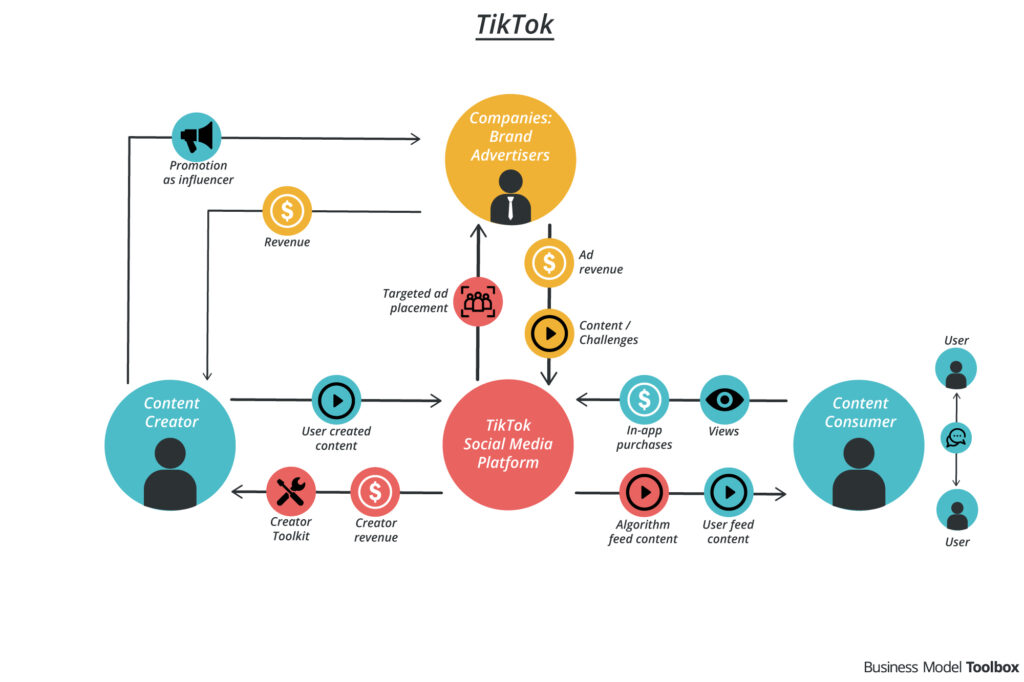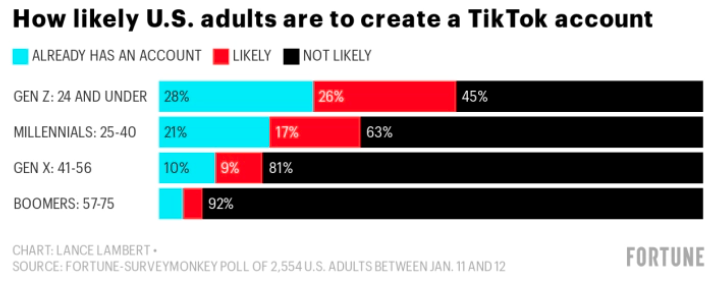TikTok but the Party Don’t Stop, No

TikTok, the real winner of the pandemic – aligning user needs, business strategy, and phenomenal growth
If there’s any industry that has benefitted vastly from the pandemic, it has to be everything digital. As lockdowns, social distancing, and quarantine protocols took over different parts of the world, so did scrolling (and doom-scrolling) on our phone screens. A real winner to emerge out of the pandemic though, was the content giant, TikTok, founded in 2016. It enjoyed $1.9B in revenue in 2020 and as of date, has an estimated 1B+ users across 150 markets. For reference, Facebook, the most popular social networking app, has a user base of 2.8B. Out of 4.8 billion internet users worldwide, 20.83% use TikTok.
So how did this wildly popular platform emerge as a winner in the pandemic?
Operations Model

TikTok generates significant value across three key user personas:
Content Creators: TikTok has democratized access to content creation – making stars and digital earners out of regular people for whom it’s made easier to make a relatable and trending video. Content creators can also evolve to become influencers if they have a large enough following – thus monetizing their content in partnership with brands. Further, being part of a community of creators ensures that creators have inspiration to make even more creative and appealing content – assisted by the toolkits and templates offered by other creators and TikTok itself. All of these combined with the personalized data and insights that a creator can generate has led to the average creator with 100K+ followers raking in $200-1000/month.
Brands: For brands, TikTok can revolutionize the way advertising and social media teams work. Content creation by brands that aligns with popular social media trends can change the face of how brands interact with their consumers – displaying a more intimate and human face to the brand. Further, the wealth of data accumulated by TikTok enables targeted advertisements for users and a bottomless well of advertisers/talent to draw from. In fact, TikTok offers the TikTok for Business platform for TikTok Ads Managers to customize ad campaigns.
Audiences: Not everyone on TikTok is a creator – and many of their users are part of the community as audiences that don’t actively create content but very actively consume it. As people social distanced and physically isolated during the pandemic, video content consumption shot up. 61% Gen Z and millennial respondents in a 2020 survey revealed that they were watching more videos – and the largest share of this increase was captured by social media apps (61%). It is not only the Gen Z and millennials though – other segments of the US population already have a TikTok account or would be open to having one. TikTok’s wealth of data enables it to curate content for its users, which in turn generates revenues from views and in-app purchases.

Beyond these three segments, it has unexpectedly also created some value for:
Competitors: In a twisted fate of events – which is not unsurprising for digital platforms though – TikTok serves to generate some value for its competitors like Instagram and other video sharing platforms. Thanks to the cross-pollination of video content across platforms – companies like Instagram witness an increase volume of posts and interactions generated by TikTok videos cross-posted to Instagram. Combined with the feature of in-app purchases that also exists in Instagram, it can serve to generate revenue for Instagram as well. Many creators often prefer to use TikTok to create their videos but monetize them across social media platforms – which improves the stats of other social media platforms as well. This is especially relevant for countries where TikTok has been banned – most notably, India. While users can’t create TikTok content, Instagram becomes a way of consuming TikTok content on a different platform.
Content Aggregators (think Buzzfeed, Bustle, etc.): Clickbait fuelled content creators and aggregators like Buzzfeed and Bustle seemed to be breathing their last till the world of TikTok opened up – which to them became a channel of crowdsourcing gifting ideas. It is not uncommon to come across advertisements of content aggregator platforms that promise, “50 Cute TikTok Gift Ideas Under $10”. These articles, leveraging crowdsourced products, are able to generate a commission every time a user purchases them off their referral link.
TikTok as the Pandemic Ebbs
TikTok is increasingly becoming synonymous with mobile-format video creation and sharing. With its catchy trends and booming user base – it has become a key way of connecting and collaborating virtually. Even as the pandemic ebbs, TikTok will continue to enjoy its wins – and perhaps even extend them into the offline world. TikTok dances and trends have often become part of the “real” world even before the pandemic – as can be witnessed in videos of athletes doing trendy TikTok dances in locker rooms. TikTok has helped build bridges that close the emotional gap that people felt while socially distanced – families, friends, partners, celebrities, fans, etc.
As TikTok scales, it leverages its network effects – but none seem so unique as to prevent competitors from taking over or replicating its actions. For instance, TikTok has lost access to audiences in India since June 2020 due to regulatory action – which has catapulted Instagram’s ‘Reels’ offering into popularity and mass adoption. TikTok now needs to think deeply and carefully about its safety, trust, and content policies to penetrate global markets – especially where concerns of the “morality” of content prevail. However, it truly does stand out as a clear winner in the pandemic – having successfully democratized access to content creation and consumption.



Great read! Whenever anyone mentions TikTok, I always like to think of why Vine, a very similar service, didn’t work out and eventually went out of business, while doing the same thing TikTok did but earlier. Do you think 2016 was just too early? Or did the pandemic forcing us all inside give TikTok the boost it needed to bring it into cultural relevancy?
Such a great comment about Vine. I totally agree with you, this is often something I think about as well. I’m not sure if 2016 was too early, but I think the format of vine wasn’t as conducive to sustainable adoption. One of the things that I think makes TikTok so pervasive is the culture around remixing and borrowing ideas. For example, every TikTok trend evolves as it spreads, and people adopt trends and add their own spin. This imitation leads to empowered users borrowing and building on each other’s ideas. TikTok can become very self-referential, which ultimately perpetuates its market dominance.
Very interesting, I had no idea about the cross-posting with Instagram. It would be interesting to explore how TikTok’s experience of the pandemic compared to other social media such as Instagram. And what did the pandemic stimulate TikTok to do that they wouldn’t have been working on otherwise? Perhaps, TikTok would have used the increased traffic from its users’ during the pandemic to further train their already impressive algorithm?
Great post, Snigdha! This is a fascinating business. I’m curious if you have thoughts on the company’s outlook following the recent FB/Meta earnings release and subsequent share-price drop. It sounds like Instagram is trying to compete with TikTok with its Reels platform – its fastest growing product – but the competition from TikTok has FB investors concerned. Also, it would be interesting to know what sort of impact Apple’s data privacy changes will have on the platform’s value to advertisers/brands going forward.
Thank you so much for this interesting and thorough post! I believe for apps like Tiktok, Instagram, to be viral is the key when it comes to successful software development. To market your social media gaming app nothing serves the purpose better than a prospect of your product being truly addictive. The users of TikTok are eager to spend more time on the platform. And in China, TikTok has its alternate Douyin, in there, Bytedance has developed another long video platform, Xi Gua (watermelon). And I am just very curious where Tiktok will develop in US, or worldwide in the future.
Great read! I honestly don’t use TikTok and thought this was a great rundown on the app and insight into how they’re winning during the pandemic. Also, important to know that India has banned them.
I wonder how Tik Tok’s algorithm is also a marketing strategy and entrance for users to promote a brand and make a viable living. how is Tik Tok also redefining other social media giants?